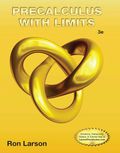
Concept explainers
To find : the solution to the given system of equation using substitution method
Answer to Problem 19E
The solutions to the given system of equation are
Explanation of Solution
Given information : The system of equation is
Concept Involved:
Solution of a system of equation is the point which makes both the equation TRUE.
Graphically the solution to the system of equation is the point where the two lines meet.
Method of Substitution:
1. Solve one of the equations for one variable in terms of the other.
2. Substitute the expression found in Step 1 into the other equation to obtain an equation in one variable.
3. Solve the equation obtained in Step 2.
4. Back-substitute the value obtained in Step 3 into the expression obtained in Step 1 to find the value of the other variable.
5. Check that the solution satisfies each of the original equations.
Calculation:
| Description | Steps |
| Label the given equation | |
| Add | |
| Combine like terms in on both sides of equation | |
| Multiply 5 throughout the equation |
Calculation (Continued):
| Description | Steps |
| Substitute | |
| Combine like terms in left side of the equation | |
| Subtract 0.5 on both sides of the equation | |
| Combine like terms in both side of the equation | |
| Divide 1.8 on both sides | |
| Simplify fraction in both sides of the equation | |
| Substitute | |
| Divide by 0.3 on both sides of the equation | |
| Simplify fraction on both sides |
Conclusion:
The solutions to the given system of equation are
Chapter 7 Solutions
EBK PRECALCULUS W/LIMITS
- i need help pleasearrow_forward(#1) Consider the solid bounded below by z = x² and above by z = 4-y². If we were to project this solid down onto the xy-plane, you should be able to use algebra to determine the 2D region R in the xy-plane for the purposes of integration. Which ONE of these limite of integration would correctly describe R? (a) y: x24x: -22 - (b) y: 22 x: 04-y² (c) y: -√√4-x2. →√√4x²x: −2 → 2 (d) z: 24-y² y: -2 → 2 (e) None of the abovearrow_forwardX MindTap - Cenxxxx Answered: tat "X A 26308049 X 10 EKU-- SP 25: X E DNA Sequenc X b/ui/evo/index.html?elSBN=9780357038406&id=339416021&snapshotid=877369& GE MINDTAP , Limits, and the Derivative 40. Answer 5 4-5 t-10 5 f(x) = 2x - 4 if x ≤0 if x 0 10 ++ -4-3-2-1 f(x) = MacBook Pro Search or type URL 5 1234 x² +1 if x = 0 if x = 0 +arrow_forward
- MindTap - Cemy X Answered: tat x A 26308049 × 10 EKU--SP 25:11 × E DNA Sequence x H. pylori index.html?elSBN=9780357038406&id=339416021&snapshotid=877369& NDTAP and the Derivative 41. 42. Answer 12 Ay 5 + -10-5 5 10 -5- f(x) = x +5 if x ≤ 0 -x²+5 if x > 0 to -5 5. 5 f(x) = |x − 1| MacBook Pro AAarrow_forwardMind Tap - Cenxxx Answered: tat X A 26308049 × 10 EKU-- SP 25: X E DNA Sequence x H. pylor vo/index.html?elSBN=9780357038406&id=339416021&snapshotld=877369& MINDTAP its, and the Derivative 44. Answer 5 X -10-5 5 10 -5. f(x) = 2 + x +5 if x 0 3 4 f(x) = x² - 1 x+1 if x = -1 MacBook Pro G Search or type URL if x = -1 + AA aarrow_forwardCalculus lll May I please have an explanation of the multivariable chain rule in the example given? Thank youarrow_forward
- Mind Tap - Cenxxx Answered: tat X A 26308049 X 10 EKU-- SP 25:1 x E DNA Sequence x H. pyl /nb/ui/evo/index.html?elSBN 9780357038406&id=339416021&snapshotid=877369& ⭑ SAGE MINDTAP a ons, Limits, and the Derivative 吃 AA In Exercises 45, 46, 47, 48, 49, 50, 51, 52, 53, 54, 55, and 56, find the values of x for which each function is continuous. 45. f(x) = 2x²+x-1 Answer▾ 46. f(x) = x³- 2x²+x-1 47. f(x) 2 = x²+1 Answer 48. f(x) = 49. f(x) = Answer 50. f(x) = 51. f(x) = I 2x²+1 2 2x - 1 x+1 x-1 2x + 1 x²+x-2 Answer↓ 52. f(x)= = x-1 x2+2x-3 53. $ % MacBook Proarrow_forward37. lim f (x) and lim f (x), where x+0+ x 0 Answer -> 38. lim f (x) and lim f (x), where +0x x―0M 2x if x 0arrow_forward37. lim f (x) and lim f (x), where x+0+ x 0 Answer -> 38. lim f (x) and lim f (x), where +0x x―0M 2x if x 0arrow_forward
- Apply the Chain Rulearrow_forwardCalculus lll May I please have the solution for the following exercise? Thank youarrow_forward2z = el+cos(x+y) 24 = olt etz dy = 1 dt dz e²² + cos (+²+1++). 2++ (1+++cos C+²+1++) (+) dz 2+. etz 2t, + 2+⋅ cos (t² +++ 1) + t (1++1 dt + cos (+²+++1) 2. W= (yz) (yz) x x=e8++ 2 y= 3² + 3st, z=sent, hallar 2w 2w د 2u 2t 25 2t AX119 S Narrow_forward
 Calculus: Early TranscendentalsCalculusISBN:9781285741550Author:James StewartPublisher:Cengage Learning
Calculus: Early TranscendentalsCalculusISBN:9781285741550Author:James StewartPublisher:Cengage Learning Thomas' Calculus (14th Edition)CalculusISBN:9780134438986Author:Joel R. Hass, Christopher E. Heil, Maurice D. WeirPublisher:PEARSON
Thomas' Calculus (14th Edition)CalculusISBN:9780134438986Author:Joel R. Hass, Christopher E. Heil, Maurice D. WeirPublisher:PEARSON Calculus: Early Transcendentals (3rd Edition)CalculusISBN:9780134763644Author:William L. Briggs, Lyle Cochran, Bernard Gillett, Eric SchulzPublisher:PEARSON
Calculus: Early Transcendentals (3rd Edition)CalculusISBN:9780134763644Author:William L. Briggs, Lyle Cochran, Bernard Gillett, Eric SchulzPublisher:PEARSON Calculus: Early TranscendentalsCalculusISBN:9781319050740Author:Jon Rogawski, Colin Adams, Robert FranzosaPublisher:W. H. Freeman
Calculus: Early TranscendentalsCalculusISBN:9781319050740Author:Jon Rogawski, Colin Adams, Robert FranzosaPublisher:W. H. Freeman
 Calculus: Early Transcendental FunctionsCalculusISBN:9781337552516Author:Ron Larson, Bruce H. EdwardsPublisher:Cengage Learning
Calculus: Early Transcendental FunctionsCalculusISBN:9781337552516Author:Ron Larson, Bruce H. EdwardsPublisher:Cengage Learning





